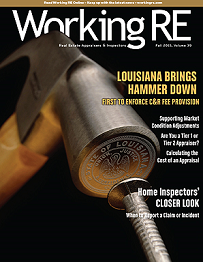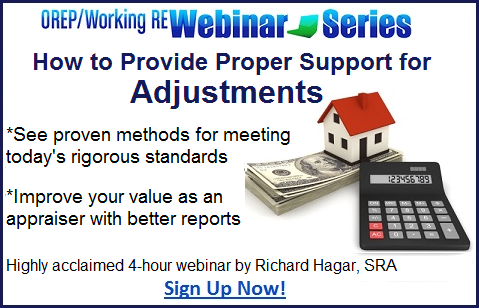 |
>> See Past News Editions >> Click to Print Protection: keep your license and your livelihood safe with the Expert’s Guide to Defensible Workfile. Click now Control: Say no to low-fee AMC work. Say YES to AMCs worth working for. Click here for an Appraiser’s Ratings and listing of the AMCs you’ll want to work for. |
Editor’s Note: This article covers the key portions of Standards Rules 2.
Understanding USPAP – Part Three: SR – 2
By Phil Spool, ASA
Standards Rule 2 relates to the report itself (Standards Rule 1 relates to the development of the report). SR 2 states “In reporting the results of a real property appraisal, an appraiser must communicate each analysis, opinion, and conclusion in a manner that is not misleading.” The key word here is misleading.
Must Not Be Misleading
Standards Rule 2-1: Each written or oral real property appraisal must:
(a) “Clearly and accurately set forth the appraisal in a manner that will not be misleading”;
(b) “Contain sufficient information to enable the intended users of the appraisal to understand the report properly”; and
(c) “Clearly and accurately disclose all assumptions, extraordinary assumptions, hypothetical conditions, and limiting conditions used in the assignment.”
Regarding SR 2-1 (a), this is one of the most important requirements of USPAP, that the report will not be considered misleading. Just about all lawsuits and state appraisal licensing board charges include this as a “violation.” For those appraisers who prepare their appraisal on a Fannie Mae appraisal report form, it would be a good idea to take advantage of the Addendum page to explain your primary reasons for the selection of comparable sales and to mention why any adjustment you made might cause a red light in the minds of the review appraiser or client when they are looking over your report. I always tell my appraisal students to prepare their appraisal report as if they will have to defend it in court or before their state Board or to a client or review appraiser who needs to understand your selection of comparables and your rationale for coming to your conclusion of value.
Standards Rule 2-2
Standards Rule 2-2 (a) is the basis for every Appraisal Report’s content. There is a list of 11 requirements in the Appraisal Report and one additional requirement if there is a need for an extraordinary assumption and/or hypothetical condition.
SR 2-2 (a) (i): “State the identity of the client, unless the client has specifically requested otherwise, state the identity of any intended users by name or type.” If the client’s name is confidential, then it has to be disclosed in the work file. Only include other intended users permitted by the client. It is also a good idea to state that “there are no other intended users.”
SR 2-2 (a) (ii): “State the intended use of the appraisal.” Remember, the intended use is not to determine the market value. That would be the type of value as required by SR 2-2 (a) (v).
(story continues below)

(story continues)
SR 2-2 (a) (iii): “Summarize information sufficiently to identify the real estate involved in the appraisal, including the physical, legal, and economic property characteristics relevant to the assignment.” You can provide the address, legal description and a brief or detailed description of the subject property.
SR 2-2 (a) (iv): “State the real property interest appraised.” Typically, but not always, this would be either the fee simple interest, leased fee interest or leasehold interest. For residential appraisers it is almost always the fee simple interest but for commercial appraisers, it could be the fee simple interest or the leased fee interest or the leasehold interest.
SR 2-2 (a) (v): “State the type and definition of value and cite the source of the definition.” Almost always you are appraising the market value of the property. The Fannie Mae form gives the market value definition but does not state the source of the definition.
SR 2-2 (a) (vi): “State the effective date of the appraisal and the date of the report.” This is for the determination if you are valuing the property for its current, retrospective (value in the past) or prospective (value in the future) value. Only Fannie Mae can state at the bottom of the conclusion of value that the date of the market value “is the date of inspection and the effective date of this appraisal.” USPAP does not make this statement.
Typically, the date of your inspection (visit to the property) is your effective date of value when preparing a current value. What happens if you did not receive all pertinent information when you were at the subject property and it takes a month or so for you to receive the information in order for you to arrive at your value conclusion? Remember, the date of the report is the date you send the report to your client. The effective date is now one month or so earlier than the date of the report, yet you consider your appraisal to be a current value. All you have to do is explain in your report the reason for the lag time between the effective date and date of the report. What should you do if a new sale closed prior to your effective date but was not available when you did your research and shows up in the public records just prior to the date of report? Good question!
SR 2-2 (a) (vii): “Summarize the scope of work used to develop the appraisal.” Sufficient information includes disclosure of research and analyses performed and might also include disclosure of research and analyses not performed. While you determine the scope of work, your client should be in agreement with it. (See Importance of a Good Scope of Work).
SR 2-2 (a) (viii): “Summarize the information analyzed, the appraisal methods and techniques employed, and the reasoning that supports the analyses, opinions, and conclusion; exclusion of the sales comparison approach, cost approach, or income approach must be explained.” You can prepare a paragraph or two in your addendum indicating the approaches you used and why, and also the approaches you did not use and why.
SR 2-2 (a) (ix): “State the use of the real estate existing as of the date of value and the use of the real estate reflected in the appraisal.” This is important when preparing a “prospective” value as the use of the real estate as it exists as of the date of value might be just vacant land or the improvements under construction. The use of the real estate reflected in the appraisal would be the end product (such as a single family residence, etc.). Therefore, a brief description of the subject property would be that the existing use is vacant land or that the improvements are under construction. This should be sufficient to satisfy this rule.
(story continues below)
SR 2-2 (a) (x): “When an opinion of highest and best use was developed by the appraiser, summarize the support and rationale for that opinion.” This is important. When checking the box “highest and best use as improved,” in your Fannie Mae form, you now have to explain your support and rationale for that opinion. Just stating the definition of highest and best use is not sufficient. Give an explanation for all four tests to determine the highest and best use. If you are doing a “prospective” market value, then you should also determine the highest and best use “as vacant.” (See Highest and Best Use Analysis).
SR 2-2 (a) (xi): “Clearly and conspicuously: state all extraordinary assumptions and hypothetical conditions; and state that their use might have affected the assignment results.” Don’t get confused between an extraordinary assumption and a hypothetical condition. An extraordinary assumption is an assumption, if found to be false, could alter the appraiser’s opinions or conclusions. A hypothetical condition is contrary to what is known to exist. For example, when preparing a “retrospective” value, you would make the extraordinary assumption that the condition of the property as of the date of inspection (visit) is the same as of the date of value (unless you are told otherwise) or if you were not able to look at all of the rooms (or rental spaces) that the condition of those areas are similar to those areas that were looked at. If you are preparing a “prospective” value, you would make the hypothetical condition that the improvements have been completed (subject to completion of plans and specifications).
SR 2-2 (a) (xii): Include a signed certification in accordance with Standards Rule 2-3. Keep in mind that this section was revised in 2014 to include “The name(s) of those providing the significant real property appraisal assistance must be stated in the certification.” While the certification does not require the appraiser to detail what work assistance was provided, somewhere in the report you should list the work, such as “measuring the improvements,” “researched for comparable sales,” “verifying the sales,” etc. This would give support to the assistant in their number of hours they participated in when preparing their appraisal log for certification.
Standards Rule 2-2 (b) applies to Restricted Appraisal Reports. It was previously referred to as a Restricted Use Appraisal Report. The basic difference between the Appraisal Report and the Restricted Appraisal Report is stated in USPAP, page U-vi # 5: “An Appraisal Report must summarize the appraiser’s analysis and the rationale for the conclusions. A Restricted Appraisal Report might not include sufficient information for the client (no other intended users are allowed) to understand either the appraiser’s analyses or rationale for the appraiser’s conclusions.”
Persistent Problems Webinar (this Thursday!)
Date: October 22nd
Identifying & Correcting Persistent Appraisal Failures: Quality, Condition, & CU – by: Richard Hagar, SRA
CU Version 3.0 is coming this September, promising “improvements” and enhancements that will undoubtedly affect how appraisers interact with their lender and AMC clients going forward. Be prepared! CU continues to flag appraisers for unsupported adjustments and erroneous Q&C ratings. In this upcoming two-part webinar, Richard Hagar, SRA shares the latest intel from his recent mettings with Fannie Mae. He shows appraisers, step by step, how to avoid the most common appraisal failures and how to “get it right” with Q&C ratings. Sign Up Now!
Fall Webinar Schedule
• Fannie Mae and Q&C Ratings – Richard Hagar, SRA (Oct. 2 parts)
• Appraisal Adjustments – Solving Common Problems – Richard Hagar, SRA (Nov. 2 parts)
• How to Create a Proper Reconciliation – Tim Andersen, MAI (available now)
• Claims, Complaints, and E&O Insurance – David Brauner (available now)
Season Ticket: $129 (Save 35% on all six webinars)
Save $78: Get the Season Ticket
About the Author
Philip G. Spool, ASA, is a State-Certified General Real Estate Appraiser in Florida, appraising since 1973. Formerly the Chief Appraiser of Flagler Federal Savings and Loan Association, he has been self-employed for the past 18 years. In addition to appraising, he is an instructor with Miami Dade College, teaching appraisal courses and continuing education. He is also the Vice President and Chairman of real estate programs with the Greater Miami Chapter of the American Society of Appraisers. He can be reached at pgspool@bellsouth.net.
>Click to Print
>New: Collateral Underwriter Blog: Find answers, offer solutions.
>Opt-In to Working RE Newsletters
Send your story submission/idea to the Editor: isaac@orep.org



by Mike Ford, CA AG; SCREA, AGA, GAA, RAA
Mr. Spool, what a timely and handy reminder for all of us. Especially those of use that use boilerplate for repetitive information that does not normally change from report to report. It gets out of date. Your explanations should already be known by all of us, however based on reports I’ve reviewed, it clearly is not. Therefore you have done a great service to those smart enough to print out and keep a copy of your article handy for reference. Nice work!
-